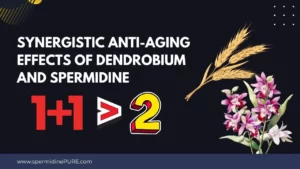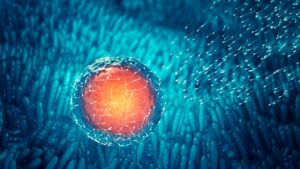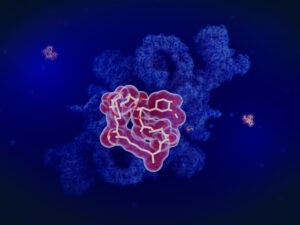Spermidine’s role in longevity and anti-aging
Spermidine is vital for cell maintenance and repair. It helps cells break down and recycle damaged parts, which keeps them healthy. Studies suggest that spermidine can slow aging by improving this process. This could prevent diseases like Alzheimer’s and cancer. However, other compounds can also promote cell health if you’re looking for alternatives.
Spermidine Longevity Mechanism: Autophagy
Inducing autophagy is one of the most critical mechanisms in promoting longevity. In recent years, spermidine has been a potent inducer of autophagy, becoming a popular topic in aging research. In this section, we will discuss the molecular mechanism by which spermidine induces autophagy and its potential as an alternative pathway for polyamine metabolism.
Polyamine Metabolism and Spermidine
Polyamines are organic molecules that play crucial roles in cell growth, differentiation, and proliferation. They are synthesized from amino acids such as arginine and ornithine through enzymatic reactions. Spermidine is one of the major polyamines found in cells, along with putrescine and spermine.
Spermidine is synthesized through two pathways: the spdsyn pathway and the alternative pathway. The spdsyn pathway involves the conversion of putrescine to spermidine through the action of spermidine synthase (SPDS). The alternative pathway consists of transforming decarboxylated S-adenosylmethionine (dcSAM) to spermidine through a series of reactions catalyzed by AdoMetDC, SPMS, PAOX, and AMD1.
Molecular Mechanism of Spermidine-Induced Autophagy
The molecular mechanism by which spermidine induces autophagy is unique compared to other known autophagy-inducing agents. It involves the inhibition of histone acetyltransferases (HATs), which leads to hypoacetylation of histones H3 and H4 at lysines 9 and 16. This increases the binding affinity between histones and chromatin, leading to chromatin condensation.
The condensed chromatin then recruits the transcription factor EB (TFEB) to the nucleus, activating the gene expression in autophagy. TFEB is a master regulator of lysosomal biogenesis and autophagy, and its activation leads to increased lysosomal function and clearance of damaged organelles and proteins.
Spermidine has also been shown to activate AMP-activated protein kinase (AMPK), a key regulator of cellular energy homeostasis. AMPK activation leads to inhibition of mTORC1, a negative regulator of autophagy. This results in increased autophagic flux and degradation of damaged cellular components.
Potential as an Alternative Pathway for Polyamine Metabolism
The alternative pathway for polyamine metabolism has gained attention due to its potential as a therapeutic target for cancer and other diseases. The enzymes in this pathway are overexpressed in many cancer cells, leading to increased polyamine synthesis and cell proliferation.
Spermidine has been shown to inhibit AdoMetDC, the first enzyme in the alternative pathway. This results in decreased polyamine synthesis and cell proliferation. Spermidine also induces apoptosis in cancer cells through activation of caspase-3 and -7.
Why is Spermidine not Enough?
Spermidine has been touted as the new anti-aging supplement to help you live longer and healthier. While it is true that spermidine has some amazing benefits, it is not enough to rely solely on this ingredient for anti-aging and longevity. In this section, we will discuss why you need more ingredients for anti-aging and longevity.
The Importance of a Balanced Diet
Spermidine alone cannot keep us young and healthy. To function well, we need a balanced diet with vitamins, minerals, protein, carbohydrates, and fats. Each nutrient has a different job in our body. For example, vitamin C boosts our immune system and calcium makes our bones strong. If we take spermidine supplements without eating right, we might miss out on other health benefits. Too much of any one nutrient can also hurt us. We must eat a balanced diet with all the essential nutrients.
The Synergistic Effect
Spermidine alone cannot entirely prevent aging and increase lifespan. Other ingredients can work together to produce a more potent effect. For example, resveratrol in red wine and quercetin in apples and onions reduce inflammation. Similarly, spermidine can work better with other anti-aging ingredients like curcumin in turmeric that protect against age-related diseases. Taking a supplement with multiple ingredients is important for optimal results.
Natural spermidine alternatives
Resveratrol: The Natural Anti-Aging Compound
Resveratrol is a natural polyphenol compound in various plants, including grapes, berries, peanuts, and Japanese knotweed. Its chemical formula is C14H12O3, and its molecular weight is 228.25 g/mol. The CAS number for resveratrol is 501-36-0.
Resveratrol reduces inflammation and oxidative stress in the body, two major contributors to aging. One of the most notable functions of resveratrol is its potential to promote longevity by activating sirtuins. Sirtuins are a class of proteins that regulate cellular health and aging processes. Resveratrol has been shown to activate sirtuin 1 (SIRT1), which helps to protect against age-related diseases such as cancer, diabetes, and neurodegenerative disorders.
Studies have also suggested that resveratrol may activate other sirtuins, such as SIRT3 and SIRT6, which play essential roles in mitochondrial function and DNA repair. By activating these sirtuins, resveratrol may help to improve overall cellular health and increase lifespan.
Quercetin: The Antioxidant Powerhouse
Quercetin is a flavonoid in many fruits and vegetables, including apples, onions, and citrus. It is known for its powerful antioxidant properties, which help protect cells from damage caused by free radicals.
In addition to its antioxidant properties, quercetin has been shown to have anti-inflammatory effects on the body. This makes it an effective treatment for conditions such as asthma and allergies.
Fisetin: A Natural Senolytic
Fisetin is a flavonoid in many fruits and vegetables, including strawberries and apples. It has been shown to have senolytic properties, which means it can help remove senescent cells from the body.
Senescent cells are damaged cells that accumulate in the body as we age. They contribute to inflammation and tissue damage, which can lead to age-related diseases such as cancer and Alzheimer’s disease. By removing these cells with fisetin supplements, it may be possible to slow down the aging process and reduce the risk of these diseases.
NMN(Nicotinamide Mononucleotide)
NMN, or Nicotinamide Mononucleotide, is a nucleotide that plays a crucial role in producing NAD+, or Nicotinamide Adenine Dinucleotide. It is a white crystalline powder with the CAS number 1094-61-7, chemical formula C11H15N2O8P, and a 334.22 g/mol molecular weight. NMN is soluble in water and ethanol but insoluble in diethyl ether.
NMN boosts NAD+ levels in cells, which are crucial for DNA repair and energy metabolism. As we age, our cells produce less NAD+, causing cellular damage and low energy. Taking NMN supplements can raise NAD+ levels, slowing aging and improving mice’s insulin sensitivity, muscle mass, cardiovascular health, and lifespan. NMN also works as a precursor to NAD+, which our bodies convert when we consume it through supplements or NMN-rich foods like broccoli or avocadoes.
NR(Nicotinamide riboside)
Nicotinamide riboside (NR) is a form of vitamin B3 gaining popularity in the health and wellness industry. It is a white crystalline powder soluble in water and ethanol, with a CAS number of 1341-23-7. The chemical formula for NR is C11H15N2O5+Cl-, with a molecular weight of 290.7 g/mol.
NR powder has many health benefits. It can activate sirtuins, which help regulate aging processes such as DNA repair and reducing inflammation. NR also increases NAD+ levels in the body, which is important for energy production and gene expression. Additionally, it may improve cognitive function and enhance exercise performance.
Fisetin
Fisetin is a naturally occurring flavonoid in the polyphenol class of compounds. It is commonly found in fruits and vegetables such as strawberries, apples, persimmons, grapes, onions, and cucumbers. The chemical formula for fisetin is C15H10O6, with a molecular weight of 286.24 g/mol. Its CAS number is 528-48-3.
Fisetin is good for you because it has many benefits, like fighting inflammation, cancer, and heart disease. It can also help with Alzheimer’s, Parkinson’s, diabetes, and obesity. Plus, fisetin can make you live longer! Studies show that it has extended the lifespan of yeast, fruit flies, worms, and mice.
The mechanism by which fisetin exerts its longevity-promoting effects is not fully understood. However, it has been suggested that fisetin activates several pathways involved in aging and age-related diseases, such as sirtuins (SIRT1), AMP-activated protein kinase (AMPK), mammalian target of rapamycin (mTOR), insulin/insulin-like growth factor-1 (IGF-1) signaling pathway.
5-deazaflavin
5-Deazaflavin is a chemical compound that belongs to the flavin family. Its CAS number is 1072-21-7, and its chemical formula is C11H9N3O2. The molecular weight of this compound is 215.21 g/mol. It is yellow-orange and is soluble in water, ethanol, and other organic solvents.
Studies have shown that 5-deazaflavin has anti-inflammatory properties that can help reduce inflammation in the body. Chronic inflammation has been linked to various diseases such as cancer, heart disease, and Alzheimer’s. By reducing inflammation, 5-deazaflavin may help improve overall health and increase longevity.
5-deazaflavin is important for enzymes that help with energy production, DNA repair, and electron transfer in cells. It’s also an antioxidant that protects cells from damage caused by unstable molecules called free radicals. Studies suggest 5-deazaflavin may help treat cancer and neurodegenerative diseases like breast cancer.
PQQ Disodium Salt
Pyrroloquinoline quinone (PQQ) is a redox cofactor found in foods such as kiwifruit, green peppers, papaya, and tofu. It was first discovered in 1979 by J.G. Hauge as a growth factor for bacteria. PQQ disodium salt is a water-soluble compound with the chemical formula C14H4N2Na2O8 and 374.17 g/mol molecular weight. Its CAS number is 122628-50-6.
Studies have shown that PQQ has anti-aging properties due to its ability to stimulate mitochondrial biogenesis, which leads to increased energy production and improved cellular function. Mitochondria are known as the powerhouses of cells because they generate ATP, the primary energy source for cells. As we age, our mitochondria become less efficient at producing ATP, leading to decreased energy levels and increased oxidative stress.
NMNH(Reduced NMN)
Reduced Nicotinamide Mononucleotide (NMNH) is a derivative of Nicotinamide Adenine Dinucleotide (NAD+), which is an essential coenzyme in redox reactions. The chemical formula of NMNH is C11H15N2O8P, and its molecular weight is 334.22 g/mol. The CAS number of reduced NMN is 1094-61-7.
NMNH is a white to off-white crystalline powder that dissolves readily in water. It has a pH range of 2-3 and can be stored at room temperature for up to two years without significant degradation.
NMNH is more potent than regular NMN, with some studies indicating that it may be up to ten times more effective at increasing NAD+ levels. This increased potency may be because NMNH bypasses the rate-limiting enzyme nicotinamide phosphoribosyltransferase (Nampt), which converts nicotinamide into NAD+. By skipping this step, NMNH can enter the salvage pathway for NAD+ synthesis.
NAD (Nicotinamide adenine dinucleotide)
Nicotinamide adenine dinucleotide (NAD+) is a coenzyme in all living cells. A pyridine nucleotide consists of two nucleotides joined by their phosphate groups. NAD+ has a CAS number of 53-84-9 and a chemical formula of C21H27N7O14P2. Its molecular weight is 663.43 g/mol.
NAD+ is essential in many biological processes, including metabolism, DNA repair, and gene expression. It acts as an electron carrier during cellular respiration, transferring electrons from one molecule to another to generate ATP, the cell’s energy currency.
Recent studies have shown that NAD+ is crucial in regulating the aging process. As we age, our bodies produce less NAD+, leading to a decline in cellular function and an increased risk of age-related diseases.
Supplementation with NAD+ precursors such as nicotinamide riboside (NR) or nicotinamide mononucleotide (NMN) has increased NAD+ levels in the body and improved cellular function. This can lead to enhanced mitochondrial health, increased energy production, and reduced inflammation – all contributing to healthy aging.
Quercetin
Quercetin is a flavonoid that belongs to the group of polyphenolic compounds. It is found in various fruits, vegetables, and grains, such as apples, berries, onions, kale, broccoli, and tea. The chemical formula of quercetin is C15H10O7, with a molecular weight of 302.24 g/mol. Its CAS number is 117-39-5.
Quercetin has been shown to have anti-aging properties due to its ability to activate sirtuins. Sirtuins are a class of proteins that are essential in regulating cellular processes such as DNA repair and metabolism. Studies have demonstrated that quercetin can increase the lifespan of yeast cells by up to 30%. Furthermore, it has been found to increase the lifespan of mice fed a high-fat diet by reducing oxidative stress and inflammation.
Sialic Acid
Sialic acid is a naturally occurring sugar found in the human body. It is a generic term for a group of over 50 different types of sugars characterized by their nine-carbon backbone and a carboxyl group at the end. The most common type of sialic acid in humans is N-acetylneuraminic acid (Neu5Ac). The CAS number for Neu5Ac is 131-48-6, and its chemical formula is C11H19NO9. Its molecular weight is 309.27 g/mol.
Sialic acid is vital in many biological processes, including cell-to-cell communication, immune system function, and brain development. It has been shown to have anti-inflammatory properties and may help protect against certain diseases such as cancer, Alzheimer’s disease, and autoimmune disorders.
Sialic acid has been studied for its potential to help people live longer. As we age, our sialic acid levels decrease. Some researchers think taking more sialic acid might help slow the aging process. Sialic acid could reduce inflammation linked to heart disease, diabetes, and cancer. By reducing inflammation, sialic acid might help prevent these diseases.
Ca-AKG
Calcium alpha-ketoglutarate, commonly known as Ca-AKG or calcium AKG, is a compound that contains calcium and alpha-ketoglutaric acid. Its CAS number is 51828-95-6, and its chemical formula is C10H12CaO8. The molecular weight of Ca-AKG is 316.21 g/mol.
Ca-AKG has been shown to impact longevity by affecting the mitochondria in cells. Mitochondria are responsible for producing energy within cells, and as we age, our mitochondria become less efficient at this process. Studies have shown that supplementing with Ca-AKG can improve mitochondrial function and increase lifespan in certain organisms.
Ca-AKG has many functions in the body. It can improve athletic performance, reduce inflammation, and support bone health. Studies show that taking Ca-AKG could increase endurance and reduce muscle damage in athletes. It may also help reduce inflammation by inhibiting the production of inflammatory cytokines. Lastly, supplementing with Ca-AKG could help support bone health.
Pterostilbene
Pterostilbene, a natural compound found in blueberries, grapes, and other plants, is a stilbenoid chemically similar to resveratrol. Its chemical formula is C16H16O3, with a 256.29 g/mol molecular weight. The CAS number for pterostilbene is 537-42-8.
Studies have shown that pterostilbene has anti-inflammatory and antioxidant properties that can help prevent chronic diseases such as cancer and heart disease. It has also been found to activate sirtuins, which are enzymes involved in regulating cellular aging and metabolism.
Metformin
Metformin is a medication used to treat type 2 diabetes. It is also known as Glucophage, Fortamet, and Riomet. The chemical formula for metformin is C4H11N5, and its molecular weight is 129.163 g/mol. Its CAS number is 657-24-9.
Metformin has been found to have potential longevity benefits in recent studies. David Sinclair, a renowned biologist at Harvard Medical School, has researched the drug’s effects on aging and lifespan extension in animals. His research showed that metformin can activate AMPK (adenosine monophosphate-activated protein kinase), essential in regulating energy metabolism.
Conclusion
In conclusion, while spermidine has been shown to have anti-aging and longevity benefits through its mechanism of autophagy, it is not the only option available. Natural alternatives include resveratrol, NMN, NR, fisetin, 5-deazaflavin, PQQ disodium salt, NMNH, NAD, quercetin sialic acid, Ca-AKG, pterostilbene, and metformin have all been studied for their potential anti-aging effects.
It is important to note that further research is needed to understand these natural alternatives’ efficacy and safety fully. However, they offer a promising avenue for those looking to improve their health and extend their lifespan.
As with any supplement or medication, it is essential to consult a healthcare professional before starting use. Healthy lifestyle habits such as regular exercise and a balanced diet can contribute to overall health and longevity.
Ultimately, the search for effective anti-aging solutions continues. While spermidine may be one piece of the puzzle, exploring natural alternatives offers a broader range of options for those seeking to optimize their health.



